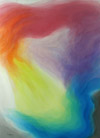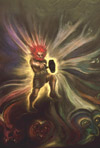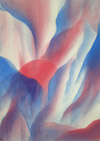 |
 Veil painting “out of the color” is a deeply meditative process in time and space, which brings visual healing to the transformational path of self discovery. The technique consists of overlapping transparent veils of watercolors on paper stretched onto a masonite board. By beginning the first stage of a painting with color instead of an idea, the painter is involved with a dynamic world of universal laws much more comprehensive than one's own creative intentions. With every brushstroke, the artist in us must respond anew to an ever-changing situation. In the second stage, a delicate structure appears as the form flows out of the color. In the third stage, the painter can recognize a possible theme or series of ideas and gradually encourage their emergence from the painting. Then the color is supported by the form (if abstract) or by the chosen motif. The art of veil painting is an integral part of the Waldorf high school curriculum.
Veil painting “out of the color” is a deeply meditative process in time and space, which brings visual healing to the transformational path of self discovery. The technique consists of overlapping transparent veils of watercolors on paper stretched onto a masonite board. By beginning the first stage of a painting with color instead of an idea, the painter is involved with a dynamic world of universal laws much more comprehensive than one's own creative intentions. With every brushstroke, the artist in us must respond anew to an ever-changing situation. In the second stage, a delicate structure appears as the form flows out of the color. In the third stage, the painter can recognize a possible theme or series of ideas and gradually encourage their emergence from the painting. Then the color is supported by the form (if abstract) or by the chosen motif. The art of veil painting is an integral part of the Waldorf high school curriculum. |
| |
 |
|
 |
 The threefold painting process of color, form and motif can be experienced in a fluid and spontaneous manner in the wet-method painting technique. The colors are allowed to flow onto the wet paper. In rapid succession, a series of creative decisions are made that stream from the heart center of the human being, uniting the consciousness and the will. This is the limitless source of the healing potential of the arts. Through a grasp of the image and luster nature of color and the three color combinations: characterless, characteristic, and harmonic, the imagination can soar with landscape moods, the seasons of the year, the festivals, and the four kingdoms of nature. The curriculum of the Waldorf elementary grades offers innumerable artistic themes from the fairy tales, animal fables, bible stories and norse myths, up to the seventh grade period of the Renaissance and the eighth grade age of revolutions.
The threefold painting process of color, form and motif can be experienced in a fluid and spontaneous manner in the wet-method painting technique. The colors are allowed to flow onto the wet paper. In rapid succession, a series of creative decisions are made that stream from the heart center of the human being, uniting the consciousness and the will. This is the limitless source of the healing potential of the arts. Through a grasp of the image and luster nature of color and the three color combinations: characterless, characteristic, and harmonic, the imagination can soar with landscape moods, the seasons of the year, the festivals, and the four kingdoms of nature. The curriculum of the Waldorf elementary grades offers innumerable artistic themes from the fairy tales, animal fables, bible stories and norse myths, up to the seventh grade period of the Renaissance and the eighth grade age of revolutions. |
| |
 |
|
| |
|
 |
 Drawing is one of the most basic forms of human expression. In the early grades children use crayon, then switch to colored pencils for their main lesson books. Themes used in the Waldorf curriculum, including the four elements, crystals and rocks, still-life objects, trees and flowers, architecture, animals and birds, the portrait, the human figure with diverse costumes and the laws of perspective can be rendered with the different drawing media: charcoal, colored chalks, pastels, crayons, pencils, watercolors and inks, collage, etc. Working with the great polarities of the two-dimensional surface: dark and light, positive and negative, straight and curved, vertical and horizontal, foreground and background, center and periphery, masses (planes) and gestures (lines), are a key to representing images from the imagination or to observing and interpreting nature. Some early work is shown in this section.
Drawing is one of the most basic forms of human expression. In the early grades children use crayon, then switch to colored pencils for their main lesson books. Themes used in the Waldorf curriculum, including the four elements, crystals and rocks, still-life objects, trees and flowers, architecture, animals and birds, the portrait, the human figure with diverse costumes and the laws of perspective can be rendered with the different drawing media: charcoal, colored chalks, pastels, crayons, pencils, watercolors and inks, collage, etc. Working with the great polarities of the two-dimensional surface: dark and light, positive and negative, straight and curved, vertical and horizontal, foreground and background, center and periphery, masses (planes) and gestures (lines), are a key to representing images from the imagination or to observing and interpreting nature. Some early work is shown in this section.
|
| |
 |
|
 |
 In the sphere of commercial art the graphic designer is challenged to combine a creative approach with a specific assignment. Illustrations and designs now serve the practical function of advertising products, services and events of all types. Images and their adjoining messages strive to attract attention in the contemporary, competitive sea of media and are extensively reproduced for the consumer market. Book club brochures can be uniquely characterized. The Rinehart Editions, a redesigned series of paperback classics, used a new logo, format and individual image for each title. An institution like Rudolf Steiner College utilizes ever-changing calendars, posters, brochures, and publications of all types throughout the year. Stage backdrops are designed for presentations and theater productions in Waldorf Schools. Websites are created for the internet to be accessed by people in search of various services.
In the sphere of commercial art the graphic designer is challenged to combine a creative approach with a specific assignment. Illustrations and designs now serve the practical function of advertising products, services and events of all types. Images and their adjoining messages strive to attract attention in the contemporary, competitive sea of media and are extensively reproduced for the consumer market. Book club brochures can be uniquely characterized. The Rinehart Editions, a redesigned series of paperback classics, used a new logo, format and individual image for each title. An institution like Rudolf Steiner College utilizes ever-changing calendars, posters, brochures, and publications of all types throughout the year. Stage backdrops are designed for presentations and theater productions in Waldorf Schools. Websites are created for the internet to be accessed by people in search of various services. |
| |
 |
|
| |
|
 |
 A spiritual overview of the visual arts: painting, sculpture and architecture, reflects the changing evolution of consciousness of the human being from the sacred mystery centers to the present era of individualism. The core of art history arose after the beginning of the Kali Yuga (Age of Darkness) 3101 BC, and continues into the Age of Light which began in 1899. Lectures include: Paleolithic and Neolithic Art, Megalithic Art, Art of Mesopotamia, Egyptian Art, Mission of Israel, Aegean and Greek Art, Etruscan, Roman and Early Christian Art, Early Medieval, Romanesque and Gothic Art, Byzantine and Russian Art, Islamic Art, Art of India and Southeast Asia, Art of China, Art of Japan, Art of the Americas, Italian Renaissance Art, Northern Renaissance Art, Mannerism and Baroque Art, Neoclassicism and Romanticism, Impressionism, Expressionism and Modern Art, Rudolf Steiner and the Visual Arts.
A spiritual overview of the visual arts: painting, sculpture and architecture, reflects the changing evolution of consciousness of the human being from the sacred mystery centers to the present era of individualism. The core of art history arose after the beginning of the Kali Yuga (Age of Darkness) 3101 BC, and continues into the Age of Light which began in 1899. Lectures include: Paleolithic and Neolithic Art, Megalithic Art, Art of Mesopotamia, Egyptian Art, Mission of Israel, Aegean and Greek Art, Etruscan, Roman and Early Christian Art, Early Medieval, Romanesque and Gothic Art, Byzantine and Russian Art, Islamic Art, Art of India and Southeast Asia, Art of China, Art of Japan, Art of the Americas, Italian Renaissance Art, Northern Renaissance Art, Mannerism and Baroque Art, Neoclassicism and Romanticism, Impressionism, Expressionism and Modern Art, Rudolf Steiner and the Visual Arts.
|
| |
 |
|
 |
 Students attending the Arts Program and other art classes with Ted Mahle over the years have come from many countries and from all walks of life. Few have had formal art training. The veil paintings, wet-method paintings and drawings shown here are examples of the quality achieved. No two paintings are alike, even those having similar themes. Every picture is a unique journey and experience for the student. Working “out of the color” allows each artist to find his/her own direction in a fluid, non-threatening manner. Confidence and skill are rapidly achieved. After the initial stages of color experience and the formative process are developed, specific motifs, which often require extensive research, are allowed to emerge. These art works show examples of imaginative themes as well as motifs from the Waldorf School Curriculum. They are copyright by the respective students and are shown as examples only.
Students attending the Arts Program and other art classes with Ted Mahle over the years have come from many countries and from all walks of life. Few have had formal art training. The veil paintings, wet-method paintings and drawings shown here are examples of the quality achieved. No two paintings are alike, even those having similar themes. Every picture is a unique journey and experience for the student. Working “out of the color” allows each artist to find his/her own direction in a fluid, non-threatening manner. Confidence and skill are rapidly achieved. After the initial stages of color experience and the formative process are developed, specific motifs, which often require extensive research, are allowed to emerge. These art works show examples of imaginative themes as well as motifs from the Waldorf School Curriculum. They are copyright by the respective students and are shown as examples only. |
| |
 |
|
| Copyright 2005 Ted Mahle & "outofthecolor.com". |
Powered by: VR Hosted. |
|